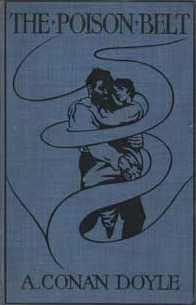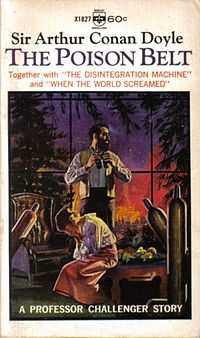The Poison Belt
 Cover of the first edition of The Poison Belt | |
| Author | Arthur Conan Doyle |
|---|---|
| Illustrator | Harry Rountree[1] |
| Country | United Kingdom |
| Language | English |
| Series | Professor Challenger |
| Genre | Science fiction novel |
| Publisher | Hodder & Stoughton |
Publication date | 1913 |
| Media type | Print (hardback) |
| Pages | 199 |
| ISBN | NA |
| Preceded by | The Lost World |
| Followed by | The Land of Mist |
The Poison Belt was the second story, a novella, that Sir Arthur Conan Doyle wrote about Professor Challenger. Written in 1913, roughly a year before the outbreak of World War I, much of it takes place in a single room in Challenger's house in Sussex – rather oddly, given that it follows The Lost World, a story set largely outdoors in the wilds of South America. This would be the last story written about Challenger until the 1920s, by which time Doyle's spiritualist beliefs had begun to influence his writing.
Plot summary
Challenger sends telegrams asking his three companions from The Lost World — Edward Malone, Lord John Roxton, and Professor Summerlee – to join him at his home outside of London. The cryptic telegrams also instruct each of them to 'bring oxygen'. On arrival they are ushered into a sealed room, along with Challenger and his wife. In the course of his researches into various phenomena, Challenger has predicted that the Earth is moving into a belt of poisonous ether which, based on its effect on the people of Sumatra earlier in the day, will cause the end of humanity. Challenger seals them in the room with cylinders of oxygen, which he (correctly) believes will counter the effect of the ether. The sealing is not to keep the ether out – it permeates everything – but "to keep the oxygen in".

The five wait out the Earth's passage through the poison belt as they watch the world outside die and machines run amok. (In an interesting display of Victorian values – or, at least, Doyle's take on them – Challenger does not even consider including his servants; they are left outside the room to die, and they continue to perform their duties until the ether overtakes them.) Finally, the last of the oxygen cylinders runs dry, and they open a window, ready to face death. To their surprise, they do not die, and conclude the Earth has now passed through the poison belt. They journey through the dead countryside in Challenger's car, finally arriving in London. They encounter only one survivor, an elderly, bed-ridden woman prescribed oxygen for her health.
After returning to Challenger's house they make plans for the future – when suddenly people start to wake up again. The effect of the ether turns out to be temporary, and the world reawakens after a little over a day in a coma, with no knowledge that they have lost any time at all. Eventually Challenger and his companions manage to convince the world what happened – a task made easier by the tremendous amount of death and destruction caused by runaway machines and fires that took place while the world was asleep – and humanity is shocked into placing a higher value on life and on the way in which we spend what little time we are given.
Dramatic adaptations
The BBC aired a radio drama version of the story in 1944, as a sequel to their well-received adaptation of The Lost World that spring.[2]
An audio recording of The Poison Belt, recorded by Mark F. Smith, is available on the Internet Archive.
References
- ↑ Facsimile of the 1st edition (1913), stating illustrator on Title page
- ↑ Carr, John Dickson, "The Many-sided Conan Doyle," in Sir Arthur Conan Doyle, The Poison Belt Together with "The Disintegration Machine" and "When the World Screamed", Berkley Medallion Books, April 1966 (2nd printing, October 1969), p.12.
External links
| Wikisource has original text related to this article: |
- The Poison Belt at Project Gutenberg
- The Poison Belt, online at Ye Olde Library
-
 The Poison Belt public domain audiobook at LibriVox
The Poison Belt public domain audiobook at LibriVox - The Poison Belt, a 1950s play. Article at The Thunder Child
